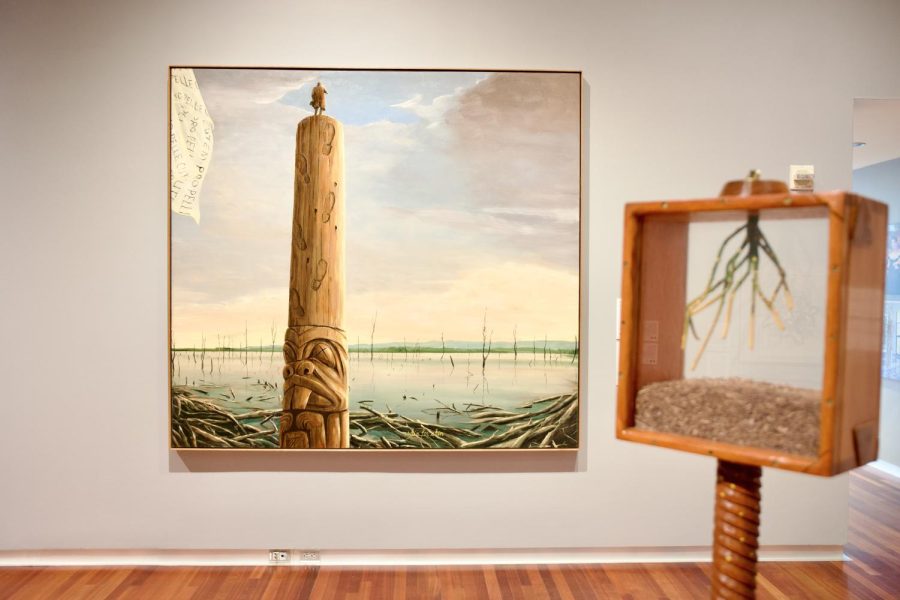A West that Never Was: UMFA Curator on their Newest Exhibition
The “Many Wests: Artists Shape America.” exhibition at the Utah Museum of Fine Arts in Salt Lake City on Tuesday, Feb. 28, 2023. (Photo by Sophie Felici | The Daily Utah Chronicle)
April 19, 2023
Currently on view at the Utah Museum of Fine Arts is an exhibition titled “Many Wests: Artists Shape an American Idea.” This collaborative exhibition takes a critical look at Western narratives and who those narratives have historically amplified — or silenced.
Devoted to Affirming Inclusivity
The UMFA recently welcomed a new senior curator: Alisa McCusker. Just below McCusker’s list of professional and academic highlights on the UMFA’s website, museum director Gretchen Dietrich makes note that the new curator is “devoted to affirming inclusivity in all aspects of her work and to harnessing art’s power to promote justice and evoke our shared humanity through critical dialogue and storytelling.”
All of these qualities made for McCusker to be the perfect private tour guide around the highly anticipated “Many Wests” exhibit. While this exhibition has been in the works for many years prior to McCusker’s arrival to the UMFA, it is the first show in which she has had an active role in executing. McCusker gave praise to her team and the previous senior curator, Whitney Tassie, for their work in putting this show together.

Never Someone’s Land to Claim
“Many Wests” attempts to tackle a multitude of longstanding issues in the art world, particularly diversity, equality and inclusion. These issues present in a number of ways including, but not limited to, lack of equal representation (in exhibited and sold artworks) of race, class, gender and sexual orientation. This collection’s examination of these themes focuses in on the Western United States.
McCusker begins our walk through the show stating, “The exhibition really tries to deal with looking at the West and sidestepping mainstream ideas about the West that have become fixed in America’s imagination, some of those being stereotypes and racist clichés. Even the idea of the white European perspective on the West is that it’s a place of expansion and a place of claiming. The truth is, this was never a someone’s land to claim — it was occupied.”
Confronting what can sometimes feel like settled narratives is no easy task and certainly not one to be accomplished without community and collaboration. With that in mind, “Many Wests” was collaboratively curated by five museums that were organized by an initiative by the Smithsonian American Art Museum in Washington, D.C. and the Art Bridges Foundation in Bentonville.
The UMFA was selected to be a part of this important project. The tapestry of the American West is far from monochromatic and this exhibition highlights the complex and arduous histories of the many unique cultures that formed and continue to sculpt the West. Artists featured in the show include those who identify as Black, Asian American, Indigenous, Latinx and LGBTQIA+.

An Underlying Element of Pain
The UMFA’s link to the local Indigenous community, namely the Shoshone, Paiute, Goshute and Ute tribes, whose ancestral land is the land upon which the museum and affiliated University of Utah stand upon, is recognized in the first gallery of the show. Many mediums of Indigenous art are featured in this gallery, ranging from photography to painting to embroidery. Each piece in its own way takes a past history told from white perspectives and gives a firsthand account. Themes in these works touch on the fetishization of native people to having to practice their tribal traditions in secret.
Deep pain is an underlying element that many of the works of this exhibition share. There are two works in particular in the main gallery that look at the harsh realities that were the Japanese internment camps prevalent in the West during World War II.
Those who entered Japanese internment camps were given numbers that acted as a sorting system, on paper tags. A powerful work by Wendy Maruyama recreated the tags of some 9,000+ internees, which hang from the gallery ceiling. The overwhelming emotion that comes from seeing the number of affected humans — a representation of only one camp — in this way makes one’s stomach sway, not unlike the mobile sculpture.
An eerily unplanned coincidence noticed by McCusker is that one of the names on this tag project is that of Roger Shimomura. Shimomura was incarcerated with his parents at Camp Minidoka in Idaho. A painting representing his time there is installed opposite Maruyama’s work.
While this exhibition doesn’t solve historic inequities, shining a light on previously ignored histories is a place where healing may begin for some. With museums being institutionally driven by colonial acquisitions, it is of utmost importance that they recognize this and do what they can to begin to decolonize the museum space.
McCusker says a personal goal of hers and of the UMFA’s going forward it to “complicate the narratives we’ve come to accept.”
It’s a beautiful start to confronting an ugly past.








